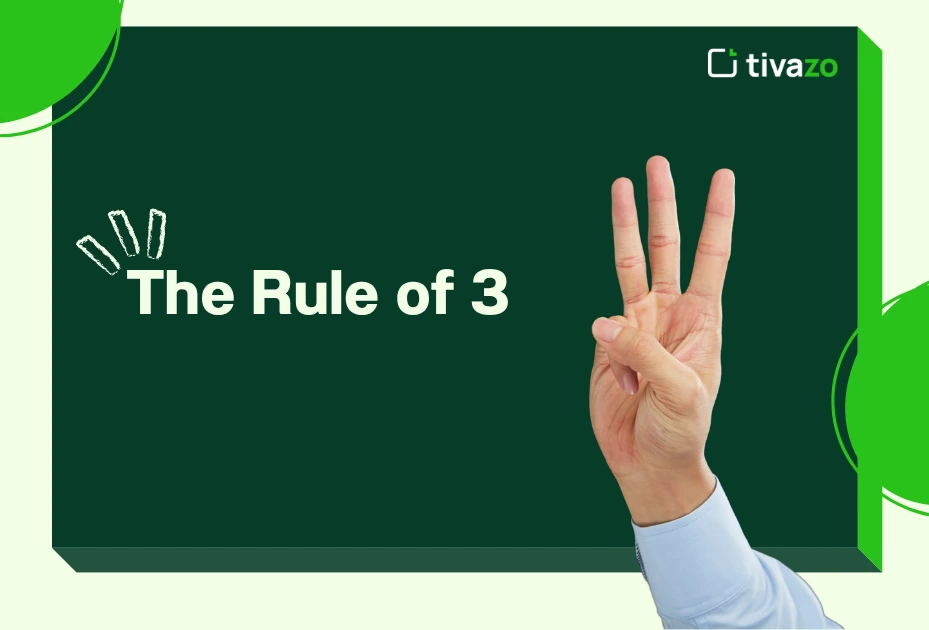Introduction:
When things are simple, they are often better for both personal and professional productivity than when they are complex. The rule of 3 then appears as a key element in making a change. Applying the rule of 3 helps you achieve your goals because it makes you focus on just three important tasks each day. It may look simple, but it brings great results. We’ll use this blog to understand how the rule of 3 can improve your productivity with science, proven cases, and strategies that really work.
What is the Rule of 3?
The rule of 3 is based on the idea that limiting your main tasks each day will help you perform better than trying to do all tasks at once. This way of playing is based on how our brains operate and make decisions. Because humans are drawn to patterns and simplicity, three is the basic number for that.
The rule of 3 allows you to spot the key tasks that will achieve the best results. It makes it easier to focus on real priorities and avoid getting distracted. With fewer urgent projects, you get to feel satisfied as soon as the three most important ones are accomplished.
The Science Behind the Rule of 3
Cognitive psychology demonstrates that our brains are characterized in a way that they process information in chunks. The rule of 3 takes advantage of this by presenting an easily processed cognitive load. The Rule of 3 writing principle is common in storytelling, advertising, and comedy because it does work.
This mental model helps eliminate decision fatigue and improve mental clarity in productivity. It is more than a hack; it is brain science.
The Rule of 3: Focused Goals for Clarity and Prioritization
Try to decide on your biggest results for each day or week by following the 3 in 3 technique. These activities or goals are ones that, if done, will contribute to feeling that the day or week has been successful.
Why it works:
When you choose only three things to focus on, you are less confused and less tired from making decisions. By using this approach, you do the most important tasks first and avoid drowning in a list of unfinished jobs.
How to do it:
- Ask yourself: “What will be the 3 important results that will make this day (or week) a success?”
- Put your ideas somewhere you can clearly see them.
- Try to handle each problem individually, putting your full attention on it
This strategy gives your day some order, so you can easily keep track of what you do and how far you have come.
Why the Rule of 3 Works
This rule is formed based on what we can process in our minds. Scientists in psychology believe that our short-term memory is best at handling 3-4 things at the same time. If you try to do even more, the efficiency of your work will reduce. With the rule of 3 approach, you use your brain to help you, and not against you.
Also, using the rule of 3 gives people a feeling of being in charge. If you have a clear and well-defined schedule, chances are you will resist procrastination. It encourages you to work hard, so your achievements and productivity continue to increase.
How to Apply the Rule of 3 to Your Daily Routine

It is helpful to use the rule of 3 in your usual daily activities.
- Morning Planning: Make sure you write down the most crucial tasks once you get up in the morning. They represent the main priorities that fit with your goals.
- Work Blocks: Set aside specific times to deal with each part of your work plan. If working alone is becoming tough, try using the Pomodoro technique.
- Review and Reflect: After you finish your work, analyze how you did. Once you have finished each step, take some time to enjoy your success. If it does not work out, figure out what interrupted your study and try to prevent that tomorrow.
By following the rule of 3 each day, you avoid gettMorning Planning: Make sure you write down the most crucial tasks once you get up in the morning. They represent the main priorities that fit with your goals.
The Rule of 3 Beyond Daily Planning
The rule of 3 is a productivity tool that is most effective not only on daily task lists. You may use it in several fields to enhance attention and sharpness:
Weekly Goals: Select three key goals you want to achieve during the week to make your attempts concentrated and not overwhelming. This will make you focus on what actually drives the needle.
Meetings: Organise meetings to have three key discussion items. This will make the discussions meaningful, allow the attendees to remain focused, and provide clear results.
Presentations: You need to structure your presentation around three main points. This makes your message more memorable and more convincing.
Emails: Drop your email messages to the three bottom lines to ensure the effectiveness of communication, as well as observing courtesy at the time of your reader.
Whatever you do, in these various settings, apply the rule of 3 and you make difficult things simple, and ensure consistent progress at work and in life.
The Rule of 3 and Time Management
Time is a resource that cannot be renewed; the rule of 3 will allow you to wisely spend it. The result is that by selecting three high-impact activities daily, you remove the clutter and do what is actually important. Doing more is not important, but doing the right things in a better manner.
In combination with time-tracking apps, such as Tivazo or Clockify, the rule of 3 will provide you with a clear image of where your time goes. This duo will help you keep in mind that you are performing according to your priorities and are not spending hours on tasks that do not add much value.
In brief, the rule of 3 adds purpose to your time that assists you in working more intelligently, rather than merely harder.
Combining the Rule of 3 with Other Productivity Techniques
The integrity with other productivity systems is one of the robust compatibilities of the rule of 3. The combination of the methods enables you to build a personalised, flexible approach that can be adjusted to your needs, workload, energy levels, and, of course, your goals.
Eisenhower Matrix: After figuring out what is urgent and important, employ the rule of 3 to pick the three tasks in that quadrant. This gives you the confidence that you are working on priorities rather than responding to the loudest thing.
Getting Things Done (GTD): GTD involves gathering and processing actions into next steps. The rule of 3 will allow you to focus on the three things you can do to advance your projects and avoid being overwhelmed by the large number of tasks.
Bullet Journaling: Bullet journaling revolves around conscious planning. Three bullets that matter most in the day can be highlighted to make you remain purposeful and focused in your journal system.
The rule of 3 really complements these approaches, and when you put them together, you have a more balanced productivity system that has both structure and flexibility to it, which makes it much easier to remain consistent and productive in the long run.
The Rule of 3 in Teams and Leadership
The rule of 3 is not only related to individuals, but it is also an effective methodology to be used by leaders and teams. It can be utilized by the leaders in order to simplify the goals and remove confusion. Rather than burying team members in a never-ending list of tasks or objectives, attempt to establish three priorities at the start of the week that are clear and high-impact. This focuses team attention, creates team alignment, and provides everybody with a sense of purpose.
This is because when everyone is aware of the top three goals, then making decisions is easier and productivity is enhanced. It even improves morale- teams are accomplished and less fractured when their works are apparently focused.
The rule of 3 is also effective in communication. Whether it is a presentation you are making, an internal update, or a strategic vision that you are describing, three points will make your message stickier and more convincing. This is why political speeches, TED Talks, and fantastic stories often use such a simple but effective structure.
The rule of 3 brings clarity to leaders. In the case of teams, it motivates performance.
Common Mistakes and How to Avoid Them

Although the rule of 3 is straightforward and works great, it can also be easily abused unless you are deliberate. The most typical trappings and the ways to evade them are the following:
Selection of Vague Tasks: It is very usual to err on the side of writing down tasks that are vague or too broad. In another example, rather than working on a project, use a draft outline for a client proposal. Measured in terms of being specific, you will know what success on each item entails.
Overloading Tasks: You should not attempt to stuff several steps in a single line item. When there are many actions involved in a task, it might easily become overwhelming. Split it into small steps and then select only three properly concentrated tasks.
Skipping Reflection: Most individuals develop their three priorities and never look at them again. Take time before you go to bed and look back: What have you done? What has interrupted your attention? How will tomorrow’s three be even keener?
These pitfalls should be avoided to make the rule of 3 quite easy, efficient, and correlated with your real priorities, not the list of your good intentions.
The Rule of 3 for Long-Term Goals
The rule of 3 does not only have to be applied to everyday or weekly duties and assignments, but it can also be applied to long-term planning. You may use it on your quarterly or yearly objectives so that you will remain focused on what really matters in the long run.
Begin by writing down three significant aspirations of the year – the ambitious victories you would like to score. Then, divide each of those goals into quarterly milestones to monitor consistent progress. Then, your weekly and daily rule of 3 planning will be a force that will assist you in making steady progress towards those long-term goals.
This establishes a great deal of congruence between the daily activities you perform and your long-range vision. Each task you accomplish seems to be meaningful as you see it is a part of a bigger thing. It seems so easy, but it is an effective method to ensure that your productivity is intentional, not only driven by urgency.
Digital Tools to Support the Rule of 3
The rule of 3 is not complicated on purpose; however, with the help of digital tools, it can become even simpler to use on a regular basis. Doing your tasks, scheduling your day, or time tracking? These tools will add order and visibility to your main priorities:
Todoist: Apply labels or create a special “Top 3” list to identify your daily priorities. You can also create reminders or repeating tasks to strengthen the habit.
Trello: Create a board and add three columns named Today 3, In Progress, and Done. It is visually possible to relocate your tasks, and this will enforce progress and keep your focus sharp.
Notion: Create a personal daily planner template having three priority boxes at the top. Use it together with task databases or journaling so that all things are in a single, streamlined workspace.
Google Keep: Create a pinned note where you will write your three tasks of the day. With its minimalistic design, it keeps distractions to a minimum and provides you with your most important priorities at a glance.
Tivazo (Time Tracking): The rule of 3 will help you to select the proper tasks to do, and time tracking will make sure that you are actually spending your time on them. Tivazo is your assistant that allows you to realize how much time every activity requires, what distracts you, and how you can modify your work process to become more focused.
Conclusion: Your Productivity Pivot Point
The rule of 3 is not a technique; it is an effective change in your perception of the day. In a world full of activities, diversions, and choices, this is one rule that can easily get you back to what is truly important: concentration, clarity, and effective action.
Regardless of who you are (student, entrepreneur, team leader, or creative), the rule of 3 can become your daily guide. It will enable you to overcome the clutter and again take charge of your time and make consistent progress toward your largest objectives. Begin tomorrow: identify the three most important tasks. Complete with purpose. Review at the end. Then do it some more .Note that productivity is not about doing everything. It is the result of doing the right things. And three is often all that it takes.




